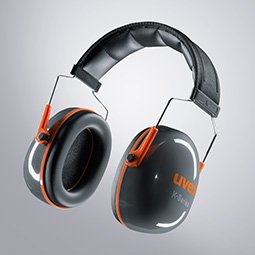Socio-economic effects of hearing loss
Noise-induced hearing loss is the most prevalent, permanent, yet preventable injury, affecting 250m people worldwide. Tinnitus, a ringing or buzzing in the ears, is reported by the World Health Organisation to be the third most serious non-fatal medical condition.
In the workplace, excess noise is one of the most universal hazards, causing irreversible hearing impairment, yet it’s a hazard that is often underestimated - possibly because it’s invisible.
Approximately 30 per cent of workers may be exposed to hazardous levels of noise at some point during their working day, with over 10 per cent always exposed to noise. According to Action on Hearing Loss, one in six people (11m) in the UK has a degree of hearing loss or is deaf, a number that is predicted to rise to one in five by 2035. One in 10 UK adults is estimated to suffer from tinnitus.
Occupational induced hearing loss is not inevitable. It can be prevented by reducing the risk of harmful noise at source, by wearing hearing protection and supported with training on its proper use.
Progressive and permanent hearing loss results from hair cells (Cilia) becoming damaged which do not regenerate. Irreversible hearing loss typically develops slowly, painlessly, often over 10 or 20 years, and may go unnoticed until it is too late.
Socio-economic effects of hearing loss
Hearing impairment, however induced, adversely affects the quality of life and lifestyle of both the individual, their families and colleagues.
Noise creates stress, interferes with communication and acts as a distraction. Sufferers may feel stigmatised, alienated and isolated from their social circles, and unhappy at work. Individuals with hearing loss are likely to be more vulnerable to accidents and find the job harder, leading to reduced productivity and affect their income.

Reclassification of hearing protection (PPE) to Cat III
The reclassification of Hearing Protection from Category II (Intermediate) to the more stringent Category III (Complex) under the new PPE Regulation (EU) 2016/425, which came into force in April 2018 and full effect from April 21st 2019, reflects the seriousness now attributed to noise induced hearing loss. PPE in Category III ‘includes exclusively the risks that may cause very serious consequences such as death or irreversible damage to health’1 meaning it must now be treated as seriously as protection from asbestos, ionising radiation, electric shocks, falls from height, bullet wounds and stabbings from a knife, drowning and low temperature environment effects comparable to -50°C.
Category III PPE is subject to a more vigorous check and surveillance, specifically formal testing by an authorised notified body – to ensure continuous compliance with prevailing standards.

The law
Thresholds of noise exposure which require employers to take specific action, if they are exceeded, are lower than people might think. Noise exposure should be measured and checked against the lower and upper Exposure Action Values (EAVs) as defined in the Control of Noise at Work Regulations 2005.
If the noise cannot be reduced at source then adequate hearing protection needs to be considered., This should be selected to match the protection required to bring the exposure down to an acceptable level. The hearing protection selected also needs to be suitable for the wearer and the environment it is to be used in. It needs to be easy to fit correctly, compatible with other PPE or equipment, hygienic and practical.
Lower and upper EAVs are an average of 80 and 85 decibels (dB) respectively measured over a day or a week. Exposure limit values are a daily or weekly average exposure of 87 dB and a peak sound pressure of 140dB. Noise exposure must not exceed these levels.
How much noise is too much noise?
| Noise level | Exposure time |
|---|---|
| 82dB | 16 hours |
| 85dB | 8 hours |
| 88dB | 4 hours |
| 91dB | 2 hours |
| 94dB | 1 hour |
| 97dB | 30 mins |
| 100dB | 15 mins |
Choosing the right hearing protection
Many different types of protection are available, such as ‘roll down’ disposable or reusable earplugs, earmuffs and customised items.
Selecting the most appropriate hearing protection is not straightforward. The wearer, the environment, the task and activity all need to be considered, as well as the protection afforded. The objective is to achieve an effective residual noise level of between 70 and 75dB once protection is correctly fitted. If the wearer is over-protected with a device that gives too much sound absorption, this can result in an inability to communicate and cause feelings of isolation.
It is widely accepted that wearer compliance caused by poorly fitted or/and uncomfortable hearing plugs (90% of products used) is the single greatest contribution to noise induced hearing loss.
It is crucial that hearing protectors are fitted correctly and worn when they need to be. This is where information, education and training is as vital as selecting the right hearing protection for the noise exposure. Hearing protection that is accompanied with training which highlights the health benefits of protecting ones hearing and ensures individuals correctly fit the devices, guarantee wearers derive the maximum and intended level of protection and ensures high levels of comfort.

The uvex group
The uvex group brings together three globally active companies under one roof: the uvex safety group, the uvex sports group (with uvex sports and Alpina Sports), and Filtral. The uvex group is represented in 22 countries by 48 subsidiaries but chooses to do most of its manufacturing in Germany. Two thirds of the company’s 2.300-strong workforce (as at 31 July, 2015) is employed in Germany. uvex is a global partner to international elite sport and equips a host of top athletes. The motto protecting people is at the heart of the company’s activities. uvex develops, manufactures and distributes products and services for the safety and protection of people at work, in sport and for leisure pursuits.
Sign up to our newsletter to receive information about our latest products, services and other interesting highlights
Sign up now


